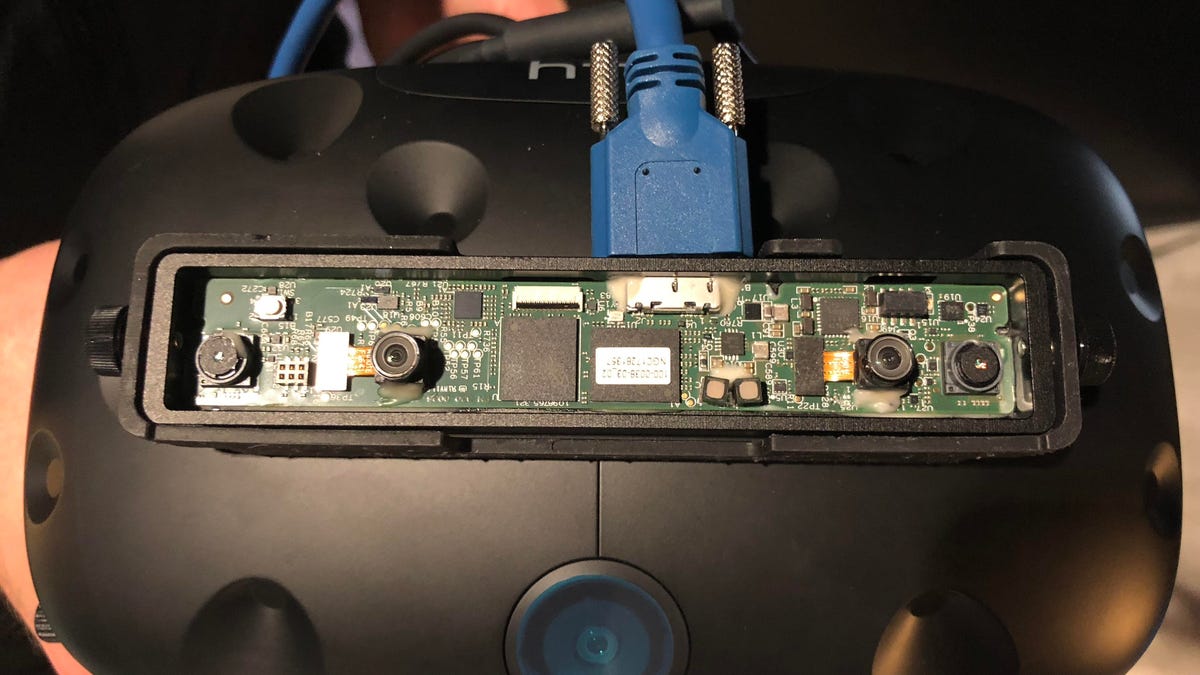One of VR's most annoying problems could be solved soon
Trying to navigate a room while wearing a VR headset? A company named Occipital has a self-contained solution to that problem.

On-headset room sensing comes to VR: Occipital's hardware on an HTC Vive.
When wandering around with a VR headset on, I'm afraid of going too far without someone to spot me. The reason is simple: I can't really see where I'm going. Odds of tripping over a chair or a table are extremely high.
One company seems to have tried to solve that problem, and I tried out the result deep in the noisy VR/AR subsection of CES in Las Vegas.
Occipital, a company based in Boulder, Colorado, focuses on 3D scanning hardware and depth-sensing cameras: One of its Structure camera sensor arrays works with both an iPhone mixed-reality headset and an upcoming home robot. Occipital's team put an HTC Vive VR headset on me, outfitted with an in-development feature that let me see the room even with my headset on. The technology is called Occipital Tracking. Its aim is to replace external room-sensing hardware completely, like the Oculus Rift's cumbersome stands or the Vive's light-emitting Lighthouse system, in favor of all in-headset tech.
Inside-out tracking, as in-headset room-tracking tech is called, has been in place on Microsoft's VR headsets and upcoming hardware like the Lenovo Mirage Solo with Daydream as well as AR devices like the Microsoft HoloLens, but Occipital Tracking aims to make that tech even better for VR with far more room-aware scanning.
A screenshot of what mapping the edges of the room and its furniture looks like in VR.
Much as Apple's ARKit or Google's ARCore can scan a room and sense edges and surfaces using a camera and the phone's motion sensor, Occipital's tech pinged my demo space and found glowing points in space that formed a map. The test demo alternated between the real world via pass-through cameras and a fully closed-off VR world with edges of the room overlaid. The VR hardware I tried had stereo cameras, but Occipital says the tracking will work with a single camera, too. It really does seem like ARKit/ARCore for VR.
Like a rough sketch, I could make out a table's edge, a line and corner indicating another obstacle (a chair). I could see walls and corners. The outlines faded when I backed away, but gained definition when I was closer, like the room boundaries that slowly appear with most VR headsets. Here, however, the boundaries were being redrawn continuously.
Those edges turn into a rainbow of skeletal lines in VR.
Occipital hopes VR headset manufacturers will build this idea into both hardware and system software. Hopefully the hardware part won't be too hard; all you need, according to Occipital, is a pair of stereo cameras and an IMU (motion sensor) that's already in the headset.
I don't want to trip over things in VR. In fact, it makes me hesitant to use wireless VR setups like HTC Vive's upcoming Pro gear.
But maybe, by this time next year, that will change. And if it's as easy to incorporate as Occipital's team promises, maybe that means more portable room-aware virtual headgear is going to come fast.
It needs to, because the future of VR isn't closed off. Our world's bound to get mixed up in it, too. Despite Microsoft and others promising that mixed reality in VR hardware, it hasn't arrived yet. Maybe this is another step toward that future.
VR and AR at CES 2018: Evolution in small steps.
HTC Vive Pro, hands-on: Better hardware is here at last.

